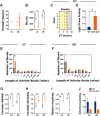Evaluation of the Digital Ventilated Cage® system for circadian phenotyping
- PMID: 39880968
- PMCID: PMC11779816
- DOI: 10.1038/s41598-025-87530-6
Evaluation of the Digital Ventilated Cage® system for circadian phenotyping
Abstract
The study of circadian rhythms has been critically dependent upon analysing mouse home cage activity, typically employing wheel running activity under different lighting conditions. Here we assess a novel method, the Digital Ventilated Cage (DVC®, Tecniplast SpA, Italy), for circadian phenotyping. Based upon capacitive sensors mounted under black individually ventilated cages with inbuilt LED lighting, each cage becomes an independent light-controlled chamber. Home cage activity in C57BL/6J mice was recorded under a range of lighting conditions, along with circadian clock-deficient cryptochrome-deficient mice (Cry1-/-, Cry2-/- double knockout). C57BL/6J mice exhibited a 24 h period under light/dark conditions, with a free-running period of 23.5 h under constant dark, and period lengthening under constant light. Animals displayed expected phase shifting responses to jet-lag and nocturnal light pulses. Sex differences in circadian parameters and phase shifting responses were also observed. Cryptochrome-deficient mice showed subtle changes in activity under light/dark conditions and were arrhythmic under constant dark, as expected. Our results show the suitability of the DVC system for circadian behavioural screens, accurately detecting circadian period, circadian disruption, phase shifts and mice with clock defects. We provide an evaluation of the strengths and limitations of this method, highlighting how the use of the DVC for studying circadian rhythms depends upon the research requirements of the end user.
Keywords: Circadian disruption; Circadian phenotyping; Circadian screen; Home cage monitoring; Individually ventilated cage; Locomotor activity.
© 2025. The Author(s).
Conflict of interest statement
Declarations. Competing interests: The authors (ST and SNP) have attended meetings funded by Tecniplast. However, Tecniplast had no involvement in the study design, data interpretation, or conclusions drawn from the research findings. As such, the authors declare no conflict of interest regarding the use of the DVC system. Ethics statement: The animal study was reviewed and approved by the Clinical Medicine Animal Welfare and Ethical Review Body (AWERB), University of Oxford.
Figures






Similar articles
-
The SnackerTracker: A novel home-cage monitoring device for measuring food-intake and food-seeking behaviour in mice.Wellcome Open Res. 2025 Jul 23;10:172. doi: 10.12688/wellcomeopenres.23850.2. eCollection 2025. Wellcome Open Res. 2025. PMID: 40861387 Free PMC article.
-
The impact of circadian rhythm disruption on oxaliplatin tolerability and pharmacokinetics in Cry1-/-Cry2-/- mice under constant darkness.Arch Toxicol. 2025 Apr;99(4):1417-1429. doi: 10.1007/s00204-025-03968-7. Epub 2025 Feb 4. Arch Toxicol. 2025. PMID: 39903276 Free PMC article.
-
The impact of shift-work light conditions on tissue-specific circadian rhythms of canonical clock genes: insights from a mouse model study.F1000Res. 2023 Aug 17;12:762. doi: 10.12688/f1000research.136998.3. eCollection 2023. F1000Res. 2023. PMID: 37576540 Free PMC article.
-
Melatonin for the promotion of sleep in adults in the intensive care unit.Cochrane Database Syst Rev. 2018 May 10;5(5):CD012455. doi: 10.1002/14651858.CD012455.pub2. Cochrane Database Syst Rev. 2018. PMID: 29746721 Free PMC article.
-
The Black Book of Psychotropic Dosing and Monitoring.Psychopharmacol Bull. 2024 Jul 8;54(3):8-59. Psychopharmacol Bull. 2024. PMID: 38993656 Free PMC article. Review.
Cited by
-
The SnackerTracker: A novel home-cage monitoring device for measuring food-intake and food-seeking behaviour in mice.Wellcome Open Res. 2025 Jul 23;10:172. doi: 10.12688/wellcomeopenres.23850.2. eCollection 2025. Wellcome Open Res. 2025. PMID: 40861387 Free PMC article.
-
Role of the period family in mediating the interplay between circadian disruption and cancer (Review).Oncol Lett. 2025 Jun 10;30(2):391. doi: 10.3892/ol.2025.15137. eCollection 2025 Aug. Oncol Lett. 2025. PMID: 40535102 Free PMC article. Review.
-
Using Machine Learning and Predictive Artificial Intelligence to Determine Cage Change Frequency for Mice Housed in Individually Ventilated Cages and Drive Vivarium Operational Efficiency.J Am Assoc Lab Anim Sci. 2025 May 1;64(4):1-14. doi: 10.30802/AALAS-JAALAS-24-151. Online ahead of print. J Am Assoc Lab Anim Sci. 2025. PMID: 40683654 Free PMC article.
References
-
- Dibner, C., Schibler, U. & Albrecht, U. The mammalian circadian timing system: Organization and coordination of central and peripheral clocks. Annu. Rev. Physiol.72, 517–549. 10.1146/annurev-physiol-021909-135821 (2010). - PubMed
-
- Foster, R. G. & Hankins, M. W. Circadian vision. Curr. Biol.17, R746–R751. 10.1016/j.cub.2007.07.007 (2007). - PubMed
Publication types
MeSH terms
Substances
Grants and funding
LinkOut - more resources
Full Text Sources
Molecular Biology Databases

